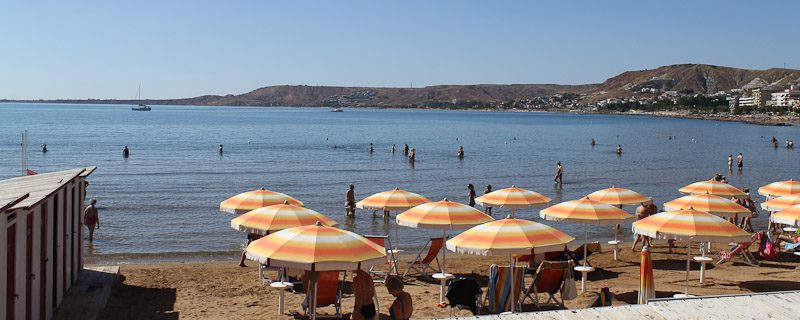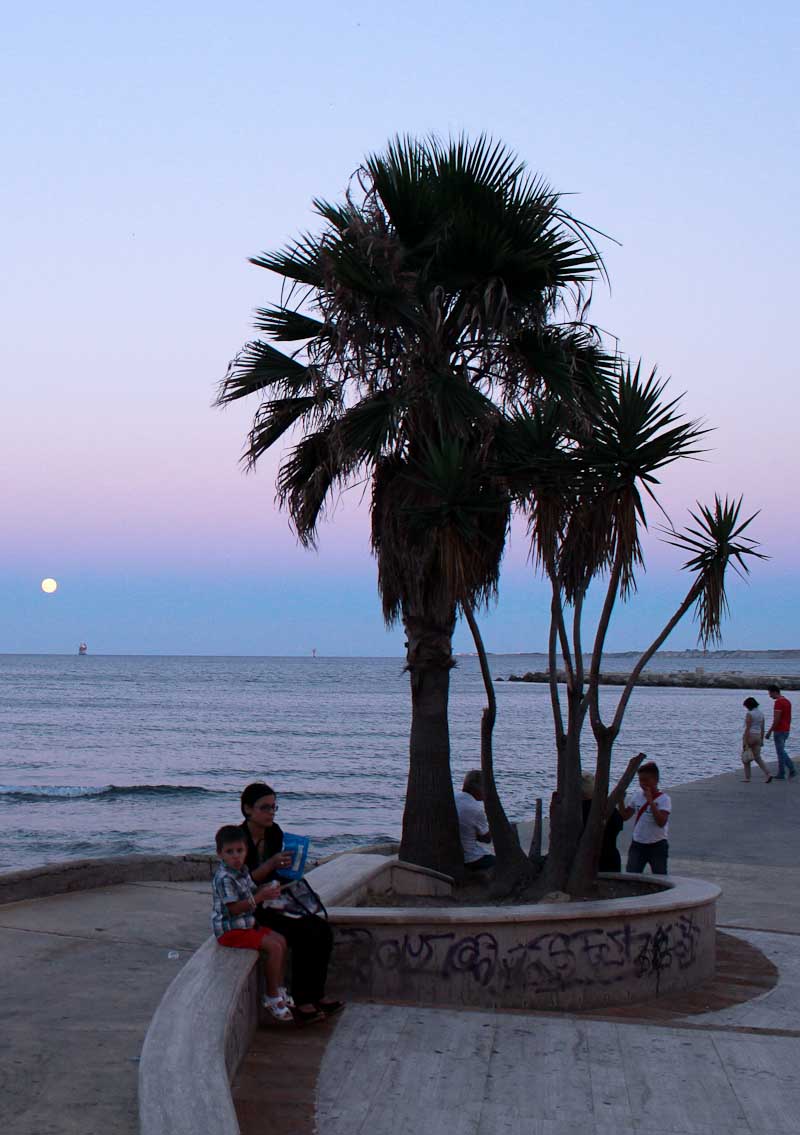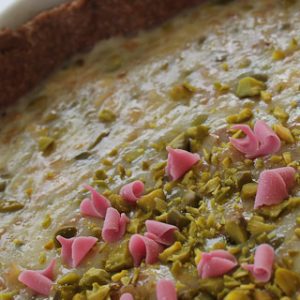The Remains of a Golden Temple at
Capo Colonna near Crotone
Once the temple at Capo Colonna near Crotone in Calabria was the most magnificent of the Greek temples in Italy. A golden landmark that has reverberated through the centuries.
It was in the era of analog photography, we visited the remains of the golden temple at Capo Colonna near Crotone. We were staying in La Castella and wanted to explore the coast and find the site of the Greek fortress complex of Hera Lacinia, mentioned in our old and dog-eared Lonely Planet.
I remember the drive out to the Lacinia promontory as one long, bumper to bumper queue through arid fields of dried out weeds, and when we arrived at Capo Colonna all possible parking spaces were crammed. You’d think such a throng indicative of a major attraction ahead, but when we finally got outside all the people had evaporated, the air stank of dust mixed with gasoline, and there was not a whiff of the strong floral perfume of wild white flowers that Guido Piovene (‘Viaggio in Italia’ 1957) thought resembled dandelions. There was nothing, apart from the view and a solitary Doric column of chiseled stone imported from Greece sometime during the 8th and 7th century BC. The column in itself wasn’t spectacular enough to merit one of the 36 pictures allotted to our tour of Calabria, so we stayed for less than 30 minutes, before embarking on the slow, hot drive back to town.
The Most Magnificent Temple in Magna Graecia
The disappointment may have made as strong an impression as any photograph, for I have wondered about the golden temple at Capo Colonna near Crotone at regular intervals since, and before our latest tour to Crotone and Rossano along the Ionian coast I collected all the writings I could find about it,
I read the 19th century English lexicographer William Smith, who cited Livy’s description of the “nobile templum, ipsa urbe nobilius” – the most splendid and sacred of all the temples in Magna Graecia with 48 Doric columns under a marble roof, greeting sailors from afar. One of the columns was of solid gold, and on an altar in the vestibule were ashes never moved by any wind. The interior was adorned with paintings of the most beautiful virgins of the city, and an immense mass of treasures accumulated on the premises. At that time the temple was situated in a grove fenced with a dense wood and tall fir trees. In the centre of the grove, cattle of every kind fed on the rich pasture without any keeper. The flocks were never killed or injured and they always returned to their fold at night.
The Roman poet Virgil made allusions to the temple at Capo Colonna in Aeneas. There were legends ascribing its foundation to the hero Hercules, who conquered lions and snakes and other wild beasts, while other legends claimed the temple was made by the sea nymph Thetis, who used it as a present to the great goddess Hera.

With field glasses the Doric column from the golden temple at Capo Colonna near Crotone might be discernible in the distance.
Enlightenment
The legends and ancient testimony of the golden temple at Capo Colonna near Crotone attracted Europeans embarking on the Grand Tour of Europe. One of the first to visit this part of Calabria – and write about it – was the German Baron von Riedesel, who saw the ruins in 1767 and described a building of enormous proportions, although only one column remained standing.
The proportions shrunk when the English travel writer Henry Swinbourne, visited the temple at Capo Colonna 10 years later.
In Travels in the two Sicilies. 1777-1780, Swinbourne describes how he darted through “a shallow bay full of shelves and islets, landed at Cape delle Colonne, known in ancient geography by the name of the Lacinian Promontory, which, with the promontory of Salentum, or St. Maria de Leuca, forms the mouth of the Tarantine Gulf, seventy miles wide. The land is very high, rocks, coarse granite, and breccia. On a point impending over the waves, are some shattered stones, and a few regular courses of building, said to be the ruins of the school of Pythagoras, and of the temple of Jumo Lacinia. About forty years ago, two columns of this edifice were still standing. One has long been fallen, the other still remains standing upon a foundation of large stones cut into facets, and serves as a landmark for navigators. Its order differs little from that of the column at Metapontum; but some bricks, which appear intermixed with the stone-work, create a doubt in my mind, whether these fragments appertain to any building so ancient as the Crotonian republic. It may have been rebuilt by the Romans, and the old columns made to serve again….”
Swinbourne goes on the claim that “Few places of worship drew so many pilgrims as this temple. At stated seasons, the roads of Italy and Greece were thronged with parties of devotees marching, with expiatory presents and votive offerings, towards the shrine of the goddess. Such a conflux of sacrifices swelled the holy treasure to an incredible value. Among heaps of ornaments of the most precious materials, was distinguished a column of solid gold. In a word, this wealth was the prototype of the golden wainscot, massive lamps, and diamond crowns of Loreto….. This temple was the scene of a barbarous action committed by Hannibal, if we are to believe the Romans, who, by destroying all records of Punic history, have taken care to prevent our bringing any proof against their assertions. They write, that Hannibal, finding himself under the necessity of obeying the summons of the Carthaginian senate, assembled all his Italian allies in this temple, and there caused such as refused to embark with him for Carthage, to be massacred by his African soldiers.”
The Lost Landmark
I take this to mean that the main attraction of the temple at Capo Colonna lies in a long list of absences combined with a strong narrative. A view that is confirmed by Richard Keppel Craven (A Tour Through The Southern Provinces Of The Kingdom Of Naples, 1821), who presumes to know what happened to the materials that were no longer at the site of the temple although he forgets to account for the column in solid gold.
“The surrounding country, comprising all that portion which forms the Lacinian promontory, and now distinguished by the name of II Marchesato, probably from the title once possessed by the Ruffo family, owners of this territory, may be looked upon as the ugliest tract of land in all Calabria. I devoted the latter part of the day, which I passed at Cotrone, to the examination of the Lacinian promontory, now called Capo Nau, or Capo delle Colonne, on which the famous temple of Juno was situated. This sanctuary might vie in days of yore with the celebrated shrine of the Ephesian Diana, or stand upon a parallel with that of Loretto in more modern times. Pilgrims from all parts of Italy and Greece flocked to it in crowds to admire the impressive style of its architecture, the magnificence of its interior ornaments, and the number of flocks sacred to the goddess, who fed un- guarded by shepherds in the ancient groves surrounding the holy edifice. Neither Pyrrhus nor Hannibal ventured to profane its treasures ; while the last was so pleased with the situation of the temple, that he passed a whole summer near its precincts. I took a boat from Cotrone, and coasting the bare ridge of uncultivated shore which runs between the town and cape, landed on the rocks forming its extremity; the ground rises abruptly, but of the pillar itself, exist around it; but the upper courses have been carried away, and leave the column apparently raised on a pedestal. The remainder of the pavement, and the materials which formed the peribolus of the temple, were all used either in the formation of the modern mole at Cotrone, or in the erection of the bishop’s palace. This promontory, by Lycophron called Storthyngon, but more usually denominated Lacinian by ancient writers, is very narrow at its extremity, but widens considerably as it recedes. Two ruined watch-towers, and three forsaken villas, testify that it was inhabited at no very distant period; but the facility of attacks from Algerine boats, and the desolate nature of the situation, have long since left them untenanted : though a small bay, formed by the curvatures on each side of the cape, still affords a place of shelter to the boats when the opposite breezes prevail.”

Materials from the golden temple at Capo Colonna were used to built moles in the harbour of Crotone
Seeing the Temple from a Distance
A hundred years later George Gissing (By the Ionian Sea, 1901) ventures to give his version of the temple legends, and he is quite satisfied with observing the Cape from a distance.
“Cotrone occupies the site of the ancient acropolis, a little headland jutting into the sea; above, and in front of the town itself, stands the castle built by Charles V., with immense battlements looking over the harbour. From a road skirting the shore around the base of the fortress one views a wide bay, bounded to the north by the dark flanks of Sila (I was in sight of the Black Mountain once more), and southwards by a long low promontory, its level slowly declining to the far-off point where it ends amid the waves. On this Cape I fixed my eyes, straining them until it seemed to me that I distinguished something, a jutting speck against the sky, at its farthest point. Then I used my field-glass, and at once the doubtful speck became a clearly visible projection, much like a lighthouse. It is a Doric column, some five-and-twenty feet high; the one pillar that remains of the great temple of Hera, renowned through all the Hellenic world, and sacred still when the goddess had for centuries borne a Latin name. “Colonna” is the ordinary name of the Cape; but it is also known as Capo di Naû, a name which preserves the Greek word naos (temple).”
With all this information I was ready to revisit the temple at Capo delle Colonna, but in the end I decided to follow Gissing’s example and stay on the battlement of the castle in Crotone looking for a speck that might be an ancient Greek column in the distance. Here the remains of the temple that have been used to build the mole are right in front of us, and we can still enjoy the Larsen effect of stories that have reverberated through the centuries, without the distraction and disappointment of a carved column made famous by the simple fact that it is still standing.

The moonlit sea, where sailors were once greeted from afar by the golden temple.



Leave a Reply
Want to join the discussion?Feel free to contribute!